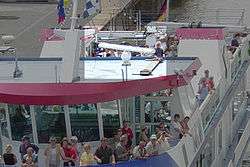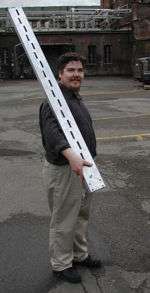Slotted waveguide

A slotted waveguide is a waveguide that is used as an antenna in microwave radar applications. Prior to its use in surface search radar, such systems used a parabolic segment reflector.
For comparison, in the parabolic type of antenna a feedhorn at the end of a waveguide directs a conical beam of output energy toward the reflector, whence it is focused into a narrow collimated beam. Reflected energy from the environment follows the reverse path and is focused by the reflector onto the feed horn where it travels back to the receiver. The reflector must be built to a precision determined by the wavelength used. For a one centimeter wavelength, a reflector precision of one or two millimeters would be adequate.

A slotted waveguide has no reflector but emits directly through the slots. The spacing of the slots is critical and is a multiple of the wavelength used for transmission and reception. The effect of this geometry is to form a high gain antenna that is highly directional in the plane of the antenna. Without augmentation a slotted waveguide is not as efficient as a parabolic reflector, lacking an ability to focus in the vertical plane, but is much more durable and is less expensive to construct. The antenna's vertical focus is usually enhanced by the application of a microwave lens attached to the front of the antenna. As this, like the companion slotted waveguide, is a one-dimensional device, it too may be made relatively cheaply as compared to a parabolic reflector and feedhorn.
Usually a slotted waveguide antenna is protected by microwave transparent material, which may visually obscure the slots. Nevertheless, it is easily distinguished from a parabolic reflector by its flat or tube shape. The wave guide contains slits with size of about 1/4 wavelength, in a distance of 1/2 wavelength.
In a related application, so-called leaky waveguides are also used in the determination of railcar positions in certain rapid transit applications. They are used primarily to determine the precise position of the train when it is being brought to a halt at a station, so that the doorway positions will align correctly with queuing points on the platform or with a second set of safety doors should such be provided.
See also
External links
- Slotted Waveguide Antennas Antenna-Theory.com